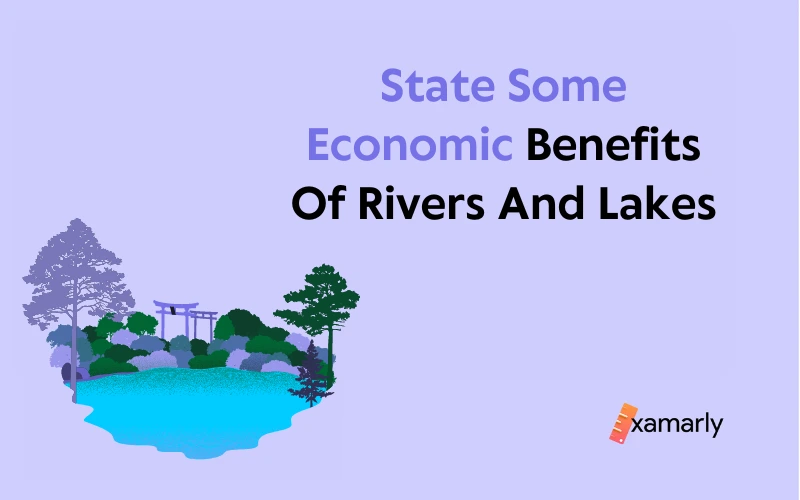The world’s rivers and lakes may seem like an idyllic natural features, but they are so much more than just a picturesque view. These bodies of water are the lifeblood of our economies, providing everything from hydroelectric power to irrigation to recreation and tourism opportunities.
They are also a vital lifeline for many communities, serving as a source of drinking water and supporting industries such as agriculture and fishing. They can even be a key factor in attracting businesses and development to the surrounding area.
But how much do we really know about the economic benefits of rivers and lakes?
In this blog, we will uncover the hidden treasures that these water bodies hold and how they contribute to the economy in ways that you may have never imagined.
- State Some Economic Benefits of Rivers and Lakes
- Generation of Hydroelectricity
- Irrigation Purposes
- Source of Freshwater
- Transportation
- Recreational Opportunities
- Fishing
- Drinking Water
- Flood Control
- Attracting Businesses and Development of Tourism
- Significance Of Lakes
- Rivers
- Applications of Rivers
- FAQs on Economic Benefits of Rivers and Lakes
- Mention some of the economic benefits of rivers and lakes.
- How does hydroelectric power generation work on rivers and lakes?
- What is the importance of irrigation for agriculture and food production?
- How do rivers and lakes support industries such as shipping and tourism?
- How can the presence of a river or lake attract businesses and development?
- Is it important to protect and preserve rivers and lakes for economic benefits?
- How can fishing contribute to the economy?
- How do rivers and lakes help to control floods?
- How do rivers impact the economy of India?
- Name the largest river basin of India.
State Some Economic Benefits of Rivers and Lakes
Although rivers and lakes are an essential component of the natural landscape, they also have a significant economic impact.
They offer many advantages, including water for transportation, hydroelectric power, recreation, and fishing. They can also serve as a source of drinking water for communities and support sectors like tourism and agriculture. Additionally, the presence of a lake or river helps draw commerce and growth to the neighborhood.
Some of the economic benefits of lakes as well as rivers are as follows:
Generation of Hydroelectricity
Hydroelectric power is generated by converting the mechanical energy of flowing water into electricity. This can be done through the use of dams, which are built on rivers and lakes.
Hydroelectric power has several advantages over other forms of energy, such as being renewable and having low operating costs. In India, the Bhakra Dam on the Sutlej River in the state of Himachal Pradesh is a major hydroelectric power generator, with an installed capacity of 1,325 megawatts.
Source: https://en.wikipedia.org
Relatable article: States And Capitals Of India: Exploring India’s Regional Diversity
Irrigation Purposes
Irrigation is the process of providing water to crops for growth and cultivation. This is an essential component of agriculture and food production.
Rivers and lakes provide a source of water for irrigation, which can help to increase crop yields and support the agricultural industry.
In India, the Kaleshwaram Lift Irrigation Project in the state of Telangana is an example of irrigation on a large scale. This project utilizes water from the Godavari River to irrigate the land.
Source of Freshwater
Freshwater only makes up 2.5% of the total volume of water on the planet, and less than 1% of that is actually usable.
For humans to survive, fresh water is required.
It is the habitat for about one-third of aquatic animals and supports the growth of fisheries, which creates jobs and improves food security.
Transportation
Rivers and lakes can be used for the transportation of goods and people, which can help to support industries such as shipping and tourism.
The use of boats and ships on rivers and lakes can save time and money compared to land-based transportation, and can also provide access to remote areas.
In India, the Brahmaputra River in the northeastern state of Assam is a major waterway for transportation, with cargo ships and passenger ferries transporting goods and people on the river.
Recreational Opportunities
Rivers and lakes provide opportunities for activities such as boating, fishing, and swimming, which can attract tourism and support local businesses. The presence of a river or lake can also increase property values and create a sense of community.
In India, the backwaters of Kerala, formed by the confluence of several rivers, are a major tourist destination, with boat rides and houseboat stays being popular activities.
Fishing
Rivers and lakes are home to many different species of fish, which can be caught and sold for food or recreation, supporting the fishing industry. Fishing can also be a source of livelihood for local communities.
In India, the Chilika Lake in the state of Odisha is the largest brackish water lagoon in the country and is home to a diverse range of fish species, supporting a large fishing industry.
Drinking Water
Rivers and lakes provide a source of drinking water for communities, which can help to support public health and save money on infrastructure costs. In India, the Ganges River is a major source of drinking water for communities in the northern states of Uttar Pradesh and Bihar.
The river is also considered holy by Hindus and is an important source of water for religious rituals.
Flood Control
Rivers and lakes can help to control floods by providing a way for excess water to be stored and released gradually. This can help to prevent damage to property and infrastructure and can also help to protect local communities.
In India, the Farakka Barrage on the Ganges River in the state of West Bengal is an example of flood control. The barrage is designed to regulate the flow of water in the river and prevent flooding in the downstream areas.
Attracting Businesses and Development of Tourism
The presence of a river or lake can attract businesses and development to the surrounding area, boosting the local economy. This can include industries such as tourism, real estate, and transportation.
In India, the city of Mumbai, located on the west coast of India, is a prime example of this. The city’s natural harbor, which is formed by the mouth of the Ulhas River, has attracted businesses such as shipping and port operations, as well as real estate development.
Significance Of Lakes
In a typical region, tectonic or glacial action results in the formation of lakes.
The bending of rivers can also result in the formation of lakes, as can human activities.
Lakes are crucial to human civilization.
There are a lot of things to mention.
The reason for this is due to the fact that lakes are a source of water, and water is an essential component for the continuation of life on this planet.
- The purpose of which is to control the flow of rivers.
- To keep water on reserve for the dry season.
- Lakes also have a positive effect on the economy since they stimulate more economic activity in the surrounding area.
- For the purpose of preserving and restoring ecological balance.
- In addition, lakes are important for recharging the groundwater.
- India is home to both freshwater and saltwater lakes, among other sorts.
- Located in India’s Jammu & Kashmir, Lake Wular is a renowned body of water. It holds the title of India’s largest freshwater lake.
- Additional two freshwater lakes in India are located in the areas of Dal, Uttarakhand, Jammu, and Kashmir:
- Bhimtal Lake and
- Nainital Lake.
- Andhra Pradesh is also home to Lake Kolleru.
- Officially designated as a wildlife sanctuary, lake Kolleru is also a popular tourist destination.
- Contributes to the enhancement and maintenance of the biodiversity found in the region surrounding the lake.
- Lake Samba of Rajasthan is a salt lake. It is important to note that this lake is one of the most producing salts in our country. Because of this, Rajasthan is now the nation’s third-largest salt producer. Fresh and saltwater combine to form brackish water.
- The biggest brackish lake in India is called Lake Chilika. The said lake is situated in the Indian State of Orissa.
Rivers
Due to the fact that the majority of rivers provide fresh water, river systems are one of the most important life support networks on Earth. Rivers are one of the primary suppliers of water on Earth.
A river is a naturally occurring, typically freshwater watercourse that flows into an ocean, sea, lake, or another river. There are some instances in which rivers run into land and become dry at the conclusion of their courses, not being able to connect with any other bodies of water. Small rivers can also be referred to as brooks, streams, and creeks.
Applications of Rivers
Throughout human history, none can ignore the significance of rivers. Some of its uses are given below:
- Rivers are an important supply of potable water, as well as water for irrigation and farming.
- China’s most populated country is supported by Asia’s greatest river.
- Important rivers clear the way for the generation of power.
- Fertile soil is guaranteed by the river in the area.
- By offering options for fishing, a significant river can serve as a business.
Winding Up
In conclusion, rivers and lakes are valuable assets for any community or region, providing numerous economic benefits such as hydroelectric power, irrigation, transportation, recreation, and fishing. They also support industries such as agriculture and tourism and can act as a source of drinking water for communities.
The examples discussed in this blog, such as the Bhakra Dam and the Kaleshwaram Lift Irrigation Project in India, demonstrate the diverse ways in which rivers and lakes can contribute to the economy. It is important to protect and preserve these resources for future generations to continue to reap their economic benefits.
In the interest of further readings:
FAQs on Economic Benefits of Rivers and Lakes
Mention some of the economic benefits of rivers and lakes.
Water is essential not only for the survival of human beings but also for the survival of other living organisms. Being a natural resource, it is an essential component that supports normally every aspect of an environment. Some of the economical advantages of lakes and rivers are:
1. Hydroelectric power generation: Rivers and lakes can be used to generate hydroelectric power through the use of dams, which convert the kinetic energy of flowing water into electricity.
2. Irrigation: Rivers and lakes provide a source of water for irrigation, which is essential for agriculture and food production.
3. Transportation: Rivers and lakes can be used for the transportation of goods and people, which can help to support industries such as shipping and tourism.
4. Recreational opportunities: Rivers and lakes provide opportunities for activities such as boating, fishing, and swimming, which can attract tourism and support local businesses.
5. Fishing: Rivers and lakes are home to many different species of fish, which can be caught and sold for food or recreation, supporting the fishing industry.
6. Drinking water: Rivers and lakes provide a source of drinking water for communities, which can help to support public health and save money on infrastructure costs.
7. Flood control: Rivers and lakes can help to control floods by providing a way for excess water to be stored and released gradually.
8. Attracting businesses and development: The presence of a river or lake can attract businesses and development to the surrounding area, boosting the local economy.
9. The improvement of natural beauty brought about by the growth in the number of lakes also aids in the development of tourism and the provision of leisure.
How does hydroelectric power generation work on rivers and lakes?
Hydroelectric power is generated by building dams on rivers and lakes, which convert the mechanical energy of flowing water into electrical energy.
What is the importance of irrigation for agriculture and food production?
Irrigation provides water to crops for growth and cultivation, which is essential for agriculture and food production. Rivers and lakes provide a source of water for irrigation, which can help to increase crop yields and support the agricultural industry.
How do rivers and lakes support industries such as shipping and tourism?
Rivers and lakes can be used for the transportation of goods and people, which can help to support industries such as shipping and tourism. The use of boats and ships on rivers and lakes can save time and money compared to land-based transportation, and can also provide access to remote areas.
How can the presence of a river or lake attract businesses and development?
The presence of a river or lake can attract businesses and development to the surrounding area, boosting the local economy. This can include industries such as tourism, real estate, and transportation.
Is it important to protect and preserve rivers and lakes for economic benefits?
Yes, it is important to protect and preserve rivers and lakes for future generations to continue to reap their economic benefits. Pollution and over-exploitation can harm these resources and negatively impact the economy.
How can fishing contribute to the economy?
Fishing can be a source of livelihood for local communities. Rivers and lakes are home to many different species of fish, which can be caught and sold for food or recreation, supporting the fishing industry.
How do rivers and lakes help to control floods?
Rivers and lakes can help to control floods by providing a way for excess water to be stored and released gradually. This can help to prevent damage to property and infrastructure and can also help to protect local communities.
How do rivers impact the economy of India?
The capacity of the river to provide water for agricultural and industrial applications is, by a wide margin, the most important contribution it makes. It also functions as a system for treating wastewater. Numerous river ports facilitate increased trade and business globally. To this end, rivers are an integral part of human existence and the global economy.
Name the largest river basin of India.
The Ganga Basin is India’s largest river basin.






